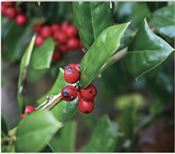Gardening Page
November Garden Tips


Plants with berries will add interest to the fall garden. Examples include: American beautyberry, deciduous holly, bittersweet, strawberry bush, holly, nandina, pyracantha, and Washington hawthorn.
- Clean up the vegetable garden and reflect back on the growing season as to what varieties performed well and what didn't.
- Most cool-season vegetables will be able to tolerate temperatures to about 28 degrees without protection but will need to be covered if temperatures are lower or if it is a clear, still night. Overturned boxes, flower pots or small high tunnels can add the protection you need.
- Spinach planted early November will overwinter and be ready for first picking late March to early April. With cold frames/hot beds, you can harvest all winter long.
- Tidy up the asparagus bed. Cut off the tops of the plants to about 3-4 inches above the soil level. Weed and add a winter dressing of compost or aged manure to the bed.
- Use wood ashes around the vegetable garden, bulb beds, and around non-acid loving plants if soil pH is below 6.0. Apply sparingly at the rate of 0.5 cup per sq. ft.
- Strawberry beds need a cleaning as well. Mulch strawberry beds to prevent winter weeds, but be careful not to cover its green leaves and crown.
- Cut faded chrysanthemums and asters to 3 inches above ground.Mulch up around them like other perennials. Newly planted mums and asters will need winter watering occasionally.
- Cut back and apply mulch to herbaceous perennials after hard frost kills the top foliage. Do not compost foliage from plants that suffered from disease problems this season. Fall garden cleanup may result in a healthier garden next season by reducing disease spores and insect eggs, which overwinter in plant material.
- It is last call to dig caladium bulbs, dahlia tubers, elephant ear corms, and ornamental sweet potato tubers for winter storage.Dahlias and elephant ears can overwinter in place if they are heavily mulched. Once they are dug, air dry for a couple of weeks before wrapping and storing in a dry cool place.
- Clean and store garden and landscape tools. Coat with a light application of oil to prevent rusting.
Water Gardens
- To help prevent a buildup of decaying leaves in your water garden, which can result in dying fish and lead to other problems, place bird netting over your pond to keep fallen leaves out during the fall until all leaves have dropped.
- For shallow ponds, consider buying a stock tank heater. This will prevent the pond from freezing over completely during the winter.
- As the weather gets colder, slow down and stop feeding your fish. They cannot metabolize food easily during cold weather. ∆
Free soil tests for Arkansans

A soil probe is the perfect tool for gathering your sample.
If you are an Arkansas homeowner or landowner and your garden or lawn isn't looking so great, maybe it's time to see how your soil is doing.
Soil testing can be done in the fall or in the spring before the lawn greens up. We offer Arkansans free soil testing. If you are interested in soil testing and are out of state, check with your state's land grant university for a similar service.
To get started, first you need to take your own soil sample.
Download our guide on how to test your soil
How to Gather Your Soil Sample
Check out the step by step video and read the instructions below.
Use the following procedure in collecting your soil sample:
1. Rake aside mulch or surface litter like leaves.
2. Take soil with a soil probe or shovel from at least 12 spots in each area to obtain a representative sample. A zigzag sampling pattern is preferred. Fertilizer and lime recommendations are no better than the sample taken.
3. Take samples in gardens, lawns, and around shrubs to a depth of about 4 inches and for mature fruit trees at a depth of 12 inches.
4. Mix soil thoroughly from a sample area. Keep different areas separate. Discard rocks, gravels and roots.
5. Allow the soil sample to air dry. Spread the sample on newspapers or large paper bags for a couple of days. Do not heat the sample in an oven to speed drying.
6. Remove one pint for the laboratory sample and place in a clean container or zip top bag. Label each sample with a name that you would recognize.
7. Bring sample(s) to your local County Extension office. Office hours are 8 a.m. to 4:30 p.m. Monday through Friday.
For Arkansas Taxpayers, there is no fee for us to process and run your samples. Out of State samples will be charged $10.00 per sample.
Tips include:
- Sample areas around shrubs separately from turf.
- If you have a large lawn or garden, sample areas separately that have been managed differently or will be managed differently.
Once your soil is gathered, Contact Your County Office to send the samples off for testing. ∆